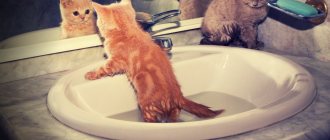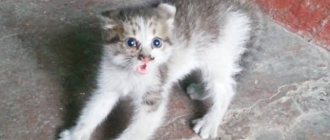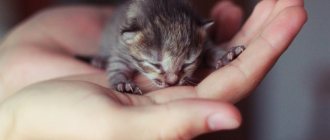Save the article:
When a small kitten appears in the house, it needs help to adapt to new conditions. The psychological comfort and health of the baby depends on this. To ensure that your furry pet’s life runs smoothly, a set of essentials is prepared for him. Great importance is attached to hygiene procedures, good nutrition, and timely vaccination. Caring for a kitten is not difficult if you follow all the rules of keeping recommended by veterinarians.
What you need to know before getting a kitten
Deciding to get a kitten is a wonderful thing, but are you sure you're ready for it? Many people forget that behind the cute fluffiness in the picture lies a lot of responsibilities for caring for a pet, expenses for its maintenance and various factors that can cause some discomfort to you as the owner.
Thus, a cute animal will regularly demand food and water, and after eating it, it will go to the toilet. And this will be repeated regularly. Are you ready to clean your cat's litter box at least once a day? But there are also picky cats who will not go into an uncleaned litter box, but will go somewhere else. For your favorite T-shirt, for example. Kittens that are not litter box trained may also go to the toilet in inappropriate places. Are you ready to endure such behavior without unnecessary emotions and raise a cat? This will require from you, at a minimum, a desire to understand the issue and considerable patience, because cats are quite difficult to educate, and it is necessary to carry out educational activities during the cat’s childhood.
The cat will need your attention, toys and various little things to care for it. He will need to be vaccinated, neutered, or sexually active. All this will require your time, effort and money. Are you ready for this?
But there will also be cat hair, which will become an integral attribute of your clothes. There will be parasites that you will have to remove not only from your pet, but also from yourself and your children, if you have them. There will be persistent awakening in the morning because, for example, the bowl is empty. There will be various harms, which may be the result of improper upbringing, or may simply be manifestations of the cat’s temperament.
Are you sure you are ready for this and want to get a kitten? You should think about this in advance, because when you meet someone in the yard, or at a flea market, or at a kitten’s house, it will be too late to think about it. No one can resist his lordship. I'll have to take it.
Fluffy kitten sitting in front of a bowl
How to properly hold a cat in your arms
In this case, you need to follow several rules with both adult animals and kittens:
- You need to approach the animal without sudden movements so that it can see you. It is best to approach from the right or left, because a direct approach may be perceived as a threat.
- You need to “get to know” the animal, let it sniff your palm or legs, for example.
- Cats usually express their desire to get to know you better, or lack thereof, with unambiguous hints: either they rub against your legs and look ingratiatingly into your eyes, or they simply move away.
- When adult cats are lifted off the ground, they are held under the front and back legs and positioned so that the cat's body is firmly supported, resting primarily on one of your arms and pressed against your body.
- When an animal shows signs of anxiety, it is better to carefully lower it to the ground.
Street kittens are often wild, so if you come across wonderful fluffy balls that want to run away from you and hiss desperately, know that they are not happy about your company, it is better to just leave them alone. You can leave them some food somewhere nearby, they won’t mind. Domestic kittens, especially purebred ones, are usually more supportive of humans and do not express much anxiety. Often they can be taken in one hand, under the tummy or, if the animals are older, in the same way as described above.
Elena, felinologist: “Every sane person can understand whether a cat wants to be held in his arms or not. If a cat avoids you, it is obvious that he is not interested in getting to know you closely. Suddenly grabbing unfamiliar cats, especially when visiting or on the street, is the last thing you should do. The animal may get scared and bite or scratch you. If the situation is favorable, let the cat sniff you, pet him and, if he doesn’t mind, pick him up. Regarding being held in your arms, every adequate person understands exactly how to position the animal in your arms so that both feel comfortable. These things should only be explained to children, preferably supported by your own example and telling them how and why not to do it. “Alas, the tendency towards sadism in childhood often manifests itself precisely in the treatment of cats, so watch how children behave towards animals and correct their behavior if necessary.”
Kitten sitting in your arms
What does a kitten need first?
There are a number of items that you should acquire before you bring a kitten into your home. First of all, this is, of course, the cat's litter box.
cat litter
A regular tray is a closed or open plastic container with high edges, filled with special compounds. At the genetic level, cats feel the need to bury traces of their vital activity, so they are attracted to loose litter on their own. In addition, living in a confined space, cats tend to go to the toilet in the same place, especially if this place is cleaned regularly.
Sand of various sizes, absorbent granules and sawdust are used as filler. What should you choose? It is better to choose experimentally. For animals, as a rule, there is not much difference. However, owners of long-haired cats are not recommended to use sawdust - it remains on the fur.
Today, automatic trays filled with absorbent granules are also sold. Although it would be more correct to call them semi-automatic, because human participation in their work is still necessary. However, they eliminate the need to react to every animal’s trip to the toilet, which is especially valuable for lazy owners and squeamish cats, or if you have to go on long business trips and there is no one to take care of the cat.
Elena, felinologist: “In most cases, there are no problems with litter box training. When you bring a kitten home, you can immediately put it in the tray, the path will become familiar. Even if he goes to the toilet somewhere else, just put the tray in that place, and the next time he goes to the tray. After the cat goes to the toilet several times, the tray can be moved step by step, moving from point to point, to the right place - the animal will go into it.”
Kitten in an open plastic tray
Bowl
Any dish from which it will be convenient for the animal to eat and drink is suitable as a cutie. These can be saucers, enamel bowls, purchased plastic feeders. Of course, they need to be washed regularly. The degree of regularity depends on the circumstances, but no one has ever gotten worse from maintaining hygiene.
Today, automatic feeders and drinkers are available on the market. This can be convenient for developing the cat's habit of eating at the right time. It also helps with gluttonous animals that are always begging you for food and get offended if you don’t give it. This is also convenient for those, again, who are forced to be away for a long time and have no one to leave the cat with - an automatic feeder will allow the animal to wait out your absence without any problems, especially when combined with an automatic tray.
Kitten drinks from a bowl
House and scratching post
Cats feel safe by “hiding” in boxes, under blankets, in closets - they need some kind of enclosed space. So a cat house out of a box is almost an ideal option.
Today, entire “playgrounds” with a house, places for climbing and grinding claws are sold. Alas, practice shows that cats prefer to climb cabinets and sharpen their claws on carpets and furniture. So it’s more practical to organize a box of rags in a cozy place and a separate scratching post.
Elena, felinologist: “I know from personal experience that all these jokes about cats and boxes are not jokes at all. Cats really love boxes, so if you want to give your pet a personal space, put something in the box and that’s it, wait. Although my cat gets along just fine without a house at all, she prefers to be covered with something and sleeps peacefully in this state. And as a scratching post, it’s most convenient to take a small board, simply rewind it with thick twine, securing its edges with small nails, and nail this structure to the wall at a level convenient for the cat, again, with nails.
You need to accustom a cat to a scratching post from childhood - when he sharpens his claws somewhere, you need to stop him, explain that this is wrong, you can lightly click him on the nose, then take him to your scratching post, move his paws along it, simulating sharpening his claws, and pet the animal, walk it and pet it. This will create a positive connection.”
The cat looks out of his house
Hygiene items
Cats need to have their nails trimmed. So you will need a nail clipper. There are, of course, special devices, but manicure nail clippers are perfect for this role.
Animals also need to brush their fur, so you will need a brush. The choice of accessory depends on the length of your animal's fur and, more importantly, its individual preferences, so there is no definite solution. You have to try.
For bathing, you will need regular towels and a special shampoo, the choice of which, again, depends on your budget and the characteristics of the animal. To clean your ears, which with normal health and a home lifestyle requires no more than once a month, ordinary swabs with cotton swabs, which you probably use to clean your ears yourself, are suitable. Some owners also brush their cats' teeth - this procedure is also not carried out more than once a month, and to carry it out you will need a special toothbrush and toothpaste. We will look at hygiene issues in more detail below.
Cat toys
Elena, felinologist: “Anything that is not nailed to the floor and can be moved by the efforts of a furry ugly creature is suitable as a toy. Kittens are ready to play with everything that rolls on the floor, including your socks, slippers and anything that fell on the floor from the table, for example. You can make toys for them yourself - balls made from tightly rolled plastic bags are excellent. Can be purchased at pet stores. It is better not to take anything with feathers - the feathers will definitely be eaten. It’s also better not to leave anything unnecessary on the floor.”
A kitten uses a scratching post on which toys are hung
Carrying
You will definitely need a container to transport the animal, for example, to the veterinarian or for a walk to get some fresh air. For these purposes, it is best to use ready-made carriers, which you can find in a sufficient assortment at your nearest pet store.
Some people carry cats in a backpack or bag, but keep in mind that the animal needs oxygen and light, and on the way it will most likely be very nervous, so when calling the cat’s “meow” you need to look at the pet, pet it and something speak in a soothing tone.
Raising a pet
If caring for newborn kittens requires complete rest, then the owner should devote more time to older babies - pick them up, accustom them to a daily routine, caress them and play. Kittens with whom a person spends enough time grow up affectionate and fearless, while babies who do not receive proper attention grow up semi-wild and too independent.
Games with a kitten
By nature, cats are nocturnal animals, so at first the kitten will be most active at night. We will have to accustom him to a daily lifestyle. To do this, all games must be played during the day or in the morning.
Cats are predators, so for best development, all games should reproduce the hunt. For example, you can tie a candy wrapper to a string and pull it in front of the kitten’s nose. He will quickly become interested in the rustling toy. Sometimes it’s worth giving in and letting him catch the “prey.” Playing with a laser pointer is also very interesting - both the owner and the kitten will enjoy it.
An unattended kitten can cause a lot of trouble.
Never pull out the toy too sharply, otherwise you can damage the claws that the kitten actively uses during play. Do not squeeze or hurt the baby - negative sensations will quickly turn the baby away from playing and interacting with the owner in general.
At the age of 2-6 months, small kittens play a lot - up to 50-60% of wakefulness. Moreover, this does not depend on human participation. If the kitten is not given due attention, he looks for fun on his own, and it may not always be pleasant. In order to avoid danger to both property and the kitten, you need to play with it for at least 1.5–2 hours a day. You should play until the cub begins to feel short of breath. If it appears already in the first minutes of the game, this is a reason to contact a veterinarian.
Pet stores offer a wide range of educational toys for kittens, such as tracks, game discs, track towers or puzzle boxes.
Photo gallery: educational toys for kittens
In the educational track there are places covered with a lid, the kitten will have to think about how to get the ball out of there. The simplest track with balls, combined with a scratching post
Here the bait jumps out of the holes, the kittens hunt for it with great pleasure
Such a toy will teach a kitten, oddly enough, thinking, because in order to extract a treat, you need to do a certain action with the toy. Balls moving along the “floors” delight not only kittens, but also adult cats
In such a toy, the bait suddenly jumps out of the holes, thus training the kitten’s reaction and dexterity
How to deal with fear and aggression
There are several reasons for the fear of a kitten:
- cats have such a feature as timidity during illness, therefore, if the kitten suddenly began to hide in secluded corners or be afraid, this is a reason to consult a veterinarian;
- the kitten may be afraid of a certain object, you should find out and eliminate the frightening object;
- It also happens that a kitten’s fear is innate, and it is possible to get rid of it only with the help of sedatives; Dr. Bach’s drops are very helpful.
Prevention and elimination of fear in a kitten involves the following actions:
- First of all, find out in which situations the baby is simply worried, and in which he experiences severe stress.
- Try not to place the kitten in stressful situations: if he is afraid of the vacuum cleaner, lock him in another room when cleaning, if he is afraid of the TV, move him to a room where there is none.
- Prevention of fear should start small. Choose a situation in which your baby is least afraid and carefully introduce it to it. For example, if your baby is afraid of people or touches, try to constantly be in the same room with him, treat him with treats and stroke him while eating.
- If the kitten has learned not to be afraid in the least stressful situations, then begin to accustom him to those in which he is more afraid. For example, if the noise of the blender causes him great fear, you should give him his favorite food while turning it on. Gradually, the blender will cease to be something terrible for him.
- Give the kitten as much attention as possible, play with it, pet it and talk to it. Often fear is associated with a lack of attention.
The baby’s fear can be dealt with with affection and gradual taming, as well as with drug therapy.
If the kitten is too aggressive, for example, in play or in contact with a person, then you can deal with this as follows:
- try to find a “golden mean” and not overdo it with the educational aspect, since the kitten may perceive your overly aggressive behavior in response as a signal that you are joining the game;
- pay enough attention to your pet;
- praise the animal when its behavior is good, and do not miss moments when the baby deserves to be scolded;
- remember that under any circumstances the use of brute force against an animal is unacceptable, this can only aggravate the situation;
- avoid stress for the kitten;
- provide the animal with a good scratching post;
- be consistent and constant, you cannot scold a kitten today for playing aggressively, and tomorrow allow him to behave with impunity;
- too severe punishments, such as spraying with water from a spray bottle, are possible only in extreme cases, when nothing helps, in such a situation, consult a veterinarian; the animal may need therapy with sedatives.
Moderate play aggression is normal for kittens
Pet safety
It is very important for a small kitten to ensure safety in a city apartment. You can do this by considering the following tips:
- It is better to keep very young kittens in one room. This way they will be in less danger and it will be easier to monitor them.
- Always check that the windows in your home are closed. A kitten can not only fall out of the window, but also get stuck in it. If you need to ventilate the house, kittens should be locked in a separate room.
- Wires also need to be carefully hidden. A kitten can receive a severe electric shock if the top layer of insulation is damaged.
- All small and breakable things must be hidden. There is a danger that the baby will swallow them or break them and get hurt.
- When you leave the house, make sure that the kitten does not slip into the entrance.
- When closing the doors, be very careful: you can easily break the kitten's tail by accidentally squeezing it.
- Check chairs or sofas before sitting on them - kittens can get under the covers.
- All toxic drugs and substances must be hidden.
- Before turning on electrical appliances, for example, a washing machine, oven, dishwasher, check them from the inside - the kitten loves to sleep in such places. If you keep your laundry in a basket before washing, you should also check it. Kittens can also get into the refrigerator, so check it every time before closing it.
- All kitten toys should be non-toxic and cannot be chewed or chewed. You should only play with toys on strings under supervision; alone, a kitten can become entangled in the string and suffocate.
Many indoor plants and flowers are dangerous for cats. Therefore, try to remove the following plants from the house where there is a kitten:
- spathiphyllum;
- ficus;
- dieffenbachia;
Dieffenbachia is a popular houseplant, but it is dangerous for cats.
- caladium;
- hydrangea (hydrangea);
- ivy (all poisonous species);
- azalea (rhododendron);
- Euphorbia (euphorbia);
- callas;
- snowdrops (water in which cut flowers have stood also becomes poisonous);
- daffodils;
- helleborus, or hellebore;
- oleander;
- lilies (these also include hyacinths and tulips), the pollen of these flowers is especially dangerous; if it remains on the fur and the kitten licks it, it can kill him;
- geranium (pelargonium);
- calendula (marigold);
- lily of the valley;
- chrysanthemum;
- violet;
- cyclamen.
The kitten carrier should be comfortable and spacious. It is better to carry babies together - this way they will be less afraid. You should not buy a carrier bag, as it will make the kittens hot and stuffy. A frame bag will not work either: it is also stuffy, and the kitten can get hurt if the frame breaks. The best option would be a plastic box. It is not only safe, but also provides kittens with normal temperature and ventilation.
How and what to feed a kitten
You have a choice of two main groups of products for feeding a kitten: industrial food and “home kitchen”.
Industrial feeds are dry loose and wet canned nutritional substances containing the optimal amount of nutrients, vitamins and microelements necessary for the animal. Canned food contains more natural meat and meat products, also enriched with vitamins and microelements. In addition, these foods contain flavoring and aromatic additives, so that animals eat them with great pleasure.
“Home cooking” is a variety of mixtures of cereals and boiled meat by-products (liver, lung, heart), ground in a blender to a homogeneous substance. It is nutritious and tasty for cats, but it is still preferable to use industrial food, as they provide a more balanced diet. Especially in “childhood” age.
The diet for kittens up to 3 months old is 5 times a day, at regular intervals; up to 8 months - 3 times a day, after - twice a day. Serving sizes are always indicated on the food packaging.
Kitten waiting for food
Elena, felinologist: “Under no circumstances buy cheap food: Whiskas, Friskes, Kitiket and the like. They contain harmful substances, chemical flavor enhancers and often do not contain many essential elements. Veterinarians recommend using Proplan and Pronature food. Previously, Royal Canin also produced good food, but several years ago the company changed owners and production was moved to another location, after which the quality of the food decreased significantly, although the price remained the same. If you want to feed cats “wet” food, it is better to boil their liver or lung.
Each brand has separate lines of food for kittens - use them. And don’t skimp on food, because proper nutrition is the most important factor in the health of your furry friend. This is especially true for purebred cats.
Veterinarians often advise combining food for kittens - a quarter wet food and three quarters dry. Practice shows that this is not necessary. If you are still worried about this, buy canned food like Butchers Clasic, Clan de File, Cosma Nature, Herrman's, Grandorf and others of a similar class. You can rarely find them in stock, but you can almost always order them.
You can feed your kitten porridge with offal starting from the age of 7–8 months. As an option, feed dry food in the morning and offal in the evening.
The most important thing is not to feed the animal “from the table” at all, but to give the prescribed food strictly in portions. Portions are usually indicated on the packages. Overfeeding is harmful to the animal's body. This is the difficulty and danger of feeding homemade cereals - you cannot accurately calculate the required serving size. So, if a cat develops allergic dermatitis from such a diet or begins to gain weight, it is better to switch to feeding exclusively industrial food and consult a veterinarian.”
The cat examines the contents of his bowl
Milk replacers for newborn kittens
Feeding newborn kittens has now become much easier - you can buy ready-made milk formula for kittens at a pet store. I recommend this particular option - an industrial substitute for cat milk, without being tied to a specific company. All of them have proven themselves well.
- Royal Canin Babycat Milk (includes measuring spoon, bottle and several nipples with holes of different diameters)
Royal Canin cat milk replacer
- Beaphar Kitty-Milk (there is a measuring spoon, but the feeding kit will have to be purchased separately)
Beafar cat milk replacer
- Gimpet Cat-Milk (no measuring cup, you can use a regular spoon, diluting the mixture 1:3 with hot water)
The dosage indicated per 100 g of kitten weight is not one-time, but daily. This amount should be evenly divided into several feedings.
Weigh your kitten to get an idea of how much food he needs.
How to care for a kitten: hygiene issues
By taking a kitten home, you automatically take responsibility for its cleanliness, which, as we know, is the key to health. Usually this function is performed by the mother cat, carefully licking her baby. But a person can cope with this task even better, and the language is useful only for communicating with an animal.
Teeth cleaning
Cats have problems with their teeth and gums, which can cause diseases of the gastrointestinal tract, skin and other systems. Brushing your teeth significantly reduces the risk of such problems. But it is necessary to accustom a cat to brushing its teeth at a very early age, so if you have a three-month-old kitten for permanent residence, brush its teeth. Toothpastes with the smell and taste of fish or meat, and a special toothbrush will help you with this - the kitten will not resist much, and after several procedures, he may even begin to like this process. You can brush your teeth once a month.
Video: Tips for brushing your cat's teeth
Nail trimming
There are special scissors for cutting cat claws, but manicure nail clippers, which are found in almost every home, are also suitable. The time to trim your nails is when their sharpness begins to cause you discomfort. It is also better to accustom an animal to this procedure from childhood, performing it once every two weeks. How far can you trim your claws? In cats with white scratches, you will be able to see the pink core in the claw - you cannot touch it, it is living tissue, so you can trim it down to it. In cats with black claws, the core is not visible and the claw is cut to a length of a millimeter and a half - this is usually enough for the animal to stop scratching too much during games.
Video: trimming claws
Ear cleaning
A cat's ears can harbor ear mites. To avoid this, you need to clean your ears once a month. If necessary, it can be done more often. The procedure is quite simple - you can moisten a swab with a cotton swab a little in peroxide (or pre-drip your ears with special drops) and gently wipe the auricle. You also need to wipe inside the ear, plunging the stick as deep as the structure of the ear allows, without much effort. Cats react to this differently, so if the animal expresses dissatisfaction, this is normal. The main thing is not to overdo it.
Video: Clean cat ears
Combing
The coat is combed once or twice a week, depending on the furiness of the kitten. As already noted, you can use any brushes that do not cause discomfort to the animal during the process. Many animals approve of hand brushes.
How to help a kitten adapt to a new home
Elena, felinologist: “It’s best to adopt a kitten at three months. Cats adapt well to new conditions, especially at a young age. So you don’t need to make any special efforts for this. Unless it is initially advised to leave the kitten in one room where its feeder, drinking bowl, tray, toys and house are located. Within a couple of days, he will completely acclimatize there and you can release him to explore the rest of the apartment. If you have other pets, you need to make sure that they get to know the new tenant. For mischievous and overly active kittens, you can use special attracting or repulsive sprays to mark those places where you should not go, or vice versa, you should. Well, don’t let children, if you have any, squeeze the animal too much, at least until the kitten grows up. Although even then, for an animal, meeting children is, as a rule, very stressful.”
Kitten plays with a special toy
Toys and other things for development and communication with a kitten
Don't forget about kitten toys. When buying toys, choose soft ones made from elastic materials. These can be balls, fur balls, mice and much more. The main thing is that the toy does not have small parts that the animal can tear off and accidentally swallow.
Don't forget, a cat is a predator, it needs to constantly play, hunt, tumble and climb. An active lifestyle allows the animal to be active and in good health. This is especially true for kittens, because in the process of play they develop their dexterity, flexibility and muscle activity. All this allows the kitten to grow and develop harmoniously.
To avoid trouble with damaged furniture, be sure to buy a scratching post. It is impossible to wean an animal from this; it is in its genes, because this is how they take care of their claws and grind them down. So just give your kitten a special place to sharpen his claws.
Basic medical aspects of cat care
You need “your” veterinarian. You can find a good specialist through personal recommendations from friends or, in extreme cases, through reviews on local forums. Look for a specialist who can come to your home.
The doctor will advise you on all necessary vaccinations, control of worms and fleas. If you have any other health problems, consult a specialist with all your questions. The Internet will only give you a general idea of what needs to be done.
It is necessary to poison the worms a week before the first vaccination, which is given at 8–9 weeks. Then the worms are poisoned every three months, up to one year. Some doctors advise continuing to treat worms with the same frequency, while others recommend deworming once every six months, for both cats and their owners.
Kittens are saved from fleas depending on their age: up to a month - combed with a soft comb; up to two months - you can already bathe with a special shampoo, for example, “Mr. Kiss"; up to three months - bathing with Fitoelita shampoo and special sprays for kittens; older than three months - you can use anti-flea drops for kittens. It is important to remember that the drops must be applied in two passes, the second time 10 days after the first. This procedure must be repeated after two months if there is a suspicion that fleas remain, or once every six months for preventive purposes.
Castration is carried out in cats after the first heat, although some sources claim that before the first heat; in cats, as soon as the animal begins to “walk”, its behavior changes, “cat songs” begin, it begins to mark its territory, etc.
Veterinarian vaccinates cat
Vaccination
To ensure that your pet is always healthy and full of strength, you cannot do without vaccinations. It is necessary to vaccinate both those kittens who walk in the yard and those who never cross the threshold of the apartment.
Kittens are first vaccinated at the age of two months, then vaccinated again when they are three months old. During the second vaccination, among other diseases, kittens are vaccinated against rabies.
The kitten will need its next vaccination at 12 months, and then vaccinations are given once a year.
You should consult your veterinarian about when to vaccinate your small pet. After examining and checking the test results, he will tell you when the baby can be vaccinated and what preparation will be required.
Features of some individual breeds: Sphynx, Scottish cats and others
Some breeds require special care.
British and Scottish cats
The British and Scots need special attention to their ears - they should always be clean, with trimmed tassels. It is also necessary to pay special attention to their coat - it is recommended to comb them at least twice a week, for at least half an hour, using massaging movements. By the way, these are the only representatives of short-haired cats who like to be combed against the grain.
Scottish fold kitten
Sphinxes
These cats are hairless and require special care. Firstly, they sweat, so they need to be wiped with a damp sponge at least once a day. Secondly, kittens of this breed do not have eyelashes, so something often gets into their eyes - they are washed either with black tea or special eye drops. Thirdly, the ears of sphinxes must be inspected daily and cleaned at the slightest hint of dirt. It is also necessary to remove hairs from the skin of sphinxes if they appear.
A very small Don Sphynx kitten
Long-haired breeds
If you have a Siberian or Persian cat, Maine Coon or other kitten with increased hairiness, you will have to purchase a lot of different scratchers and brushes, and devote enough time to combing procedures. So, a mitten brush will remove lost hairs, a slicker will remove excess undercoat, a sparse comb will comb out the main coat and massage your pet, a frequent brush will be useful for the softest places - the tummy, the inside of the paws and the area under the tail. Also, representatives of long-haired breeds often need additional vitamins, a sign of which can be active shedding in the off-season.
Red little Maine Coon kitten
Short-haired breeds
This type includes Siamese, exotic, Abyssinian, Thai and representatives of many other breeds. They do not require special care - just regularly clean their ears, teeth and eyes, comb them periodically and do not forget about anti-parasitic measures.
Satisfied kitten lies on the sofa
From a kitten to an adult cat is less than a year, so be prepared for the rapid transformation of a cute fluffy ball that requires your attention and care into a large imposing animal that, despite its apparent independence, will still be entirely dependent on you. And in return for your efforts you will receive feline gratitude, warmth and purr-purr-purr.











